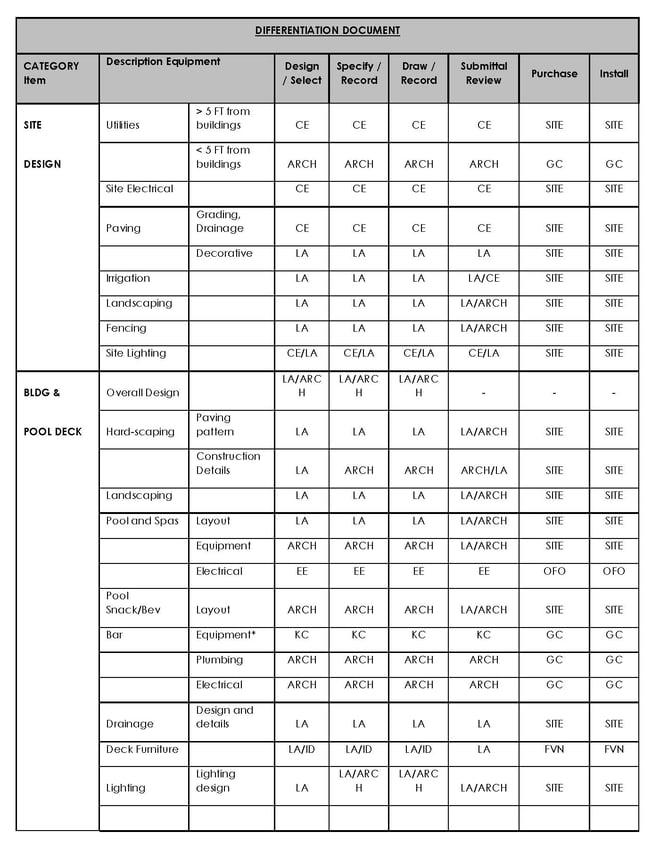Quality on a project, many times, is one of the last considerations for an Owner whom usually focuses first on cost and then schedule.
 At the end of the day, the Quality of a built project is extremely critical for a lot longer than the time it took to design and build it. In the Project Management Plan, there should be a Quality Management Plan portion. In that segment the Project Manager should outline who will be responsible for delivering quality on a project. This starts first with a good design. One of the first steps the Owner’s Representative can do is to develop a Differentiation Document that clearly outlines who will be responsible for what in a Project, similar to the following example of a site and pool area development.
At the end of the day, the Quality of a built project is extremely critical for a lot longer than the time it took to design and build it. In the Project Management Plan, there should be a Quality Management Plan portion. In that segment the Project Manager should outline who will be responsible for delivering quality on a project. This starts first with a good design. One of the first steps the Owner’s Representative can do is to develop a Differentiation Document that clearly outlines who will be responsible for what in a Project, similar to the following example of a site and pool area development.

Legend:
CE – Civil Engineer
SITE – Site Contractor
ARCH – Architect
LA – Landscape Architect
EE – Electrical Engineer
OFO – Owner Furnished Owner Installed
KC – Kitchen Consultant
GC – General Contractor
ID – Interior Designer
FVN – Furniture Vendor
 The Differentiation Document outlines who is responsible for key areas of the development and implementing the Quality Standards on the project. However, this is only the first step and defines who should be setting the Quality Standards (noted in the example above as the “Design/Select” and “Specify/Select” columns). The next step in the Quality Management Plan that should be detailed is even more important; That is selecting a good Designer or Design Team. We always recommend that a Design Team be selected on a quality based selection process. We solicit Design Firms first through a RFQ (Request for Qualifications) process where we have potential Design Teams respond to a series of questions which includes:
The Differentiation Document outlines who is responsible for key areas of the development and implementing the Quality Standards on the project. However, this is only the first step and defines who should be setting the Quality Standards (noted in the example above as the “Design/Select” and “Specify/Select” columns). The next step in the Quality Management Plan that should be detailed is even more important; That is selecting a good Designer or Design Team. We always recommend that a Design Team be selected on a quality based selection process. We solicit Design Firms first through a RFQ (Request for Qualifications) process where we have potential Design Teams respond to a series of questions which includes:
- Enclose latest print or electronic marketing literature about your firm. Include such information as Names of Principal(s), professional history, Registration status, professional affiliations, key personnel, total number of staff, number of registered Architects, honors and awards;
- Include what experience your firm has in the <specific> industry;
- What is the Organization Type of your firm: Individual or Sole Proprietorship, Professional Corporation, Corporation, Partnership, Joint Venture (if JV or other, provide details);
- Provide a description of your firm’s specific qualifications to perform the work for the proposed project. Include information such as years of experience in the building type and areas of expertise that are pertinent to the Project;
- Provide details on any projects you have completed over the past three (3) years that is similar to the intended project such as: Project Name and Location, total project cost, type of project, and contact information for references on the project.
- Provide a current backlog of your professional design contracts;
- Provide a general overview of your document quality control processes that would be used for the project;
- Describe your approach to performing code evaluations on projects;
- Include specific capabilities your firm possesses that would make it stand out from other firms;
- Include any experience your firm has at <specific location>;
- Provide resumes of Key Team Members you are planning on committing to this project if selected;
- Provide three (3) references, including names, current addresses and business telephone numbers, of clients who may be contacted. Indicate what project to which they are associated; and
- Disclose any business or personal associations, direct or indirect financial interests, or other circumstances which could be construed as creating a conflict of interest with the Owner or any possible contractors.
The purpose of this questionnaire is to solicit information from interested Design Firms about their capabilities to perform work for the Owner. This process should be detailed in the Quality Management Plan.
 The Owner’s Representative should take this information, check references and form an opinion of the capabilities of the firms who would like to propose on the design. From that review a selected short list should be developed and a written recommendation provided to the Owner.
The Owner’s Representative should take this information, check references and form an opinion of the capabilities of the firms who would like to propose on the design. From that review a selected short list should be developed and a written recommendation provided to the Owner.
Once design starts there should be an ongoing QA of the design documents by the Owner’s Representative. With modern cloud based tools, like Bluebeam, teams can collectively pull all of their comments together in one place for assisting the design team in developing a complete and constructible set of documents. This process should be detailed in the Quality Management Plan.
The last portion of the Quality Management Plan should detail how and who will be performing quality assurance checks while construction is being done as well as how and who will commission the building at the end. This could be a general statement at this stage (e.g. Owner should employ a testing and inspection firm that will be required to verify the following items and/or Owner should employ a commissioning agent who will start at Design Development phase of the project) however, it needs to be spelled out in the Plan.
A well outlined Quality Management Plan will help the Owner achieve his goals on the project and help ensure that details are put in place where all parties to the project understand the quality requirements they need to achieve for project SUCCESS!!!


